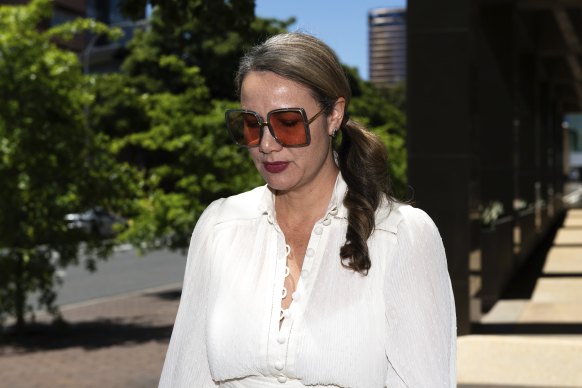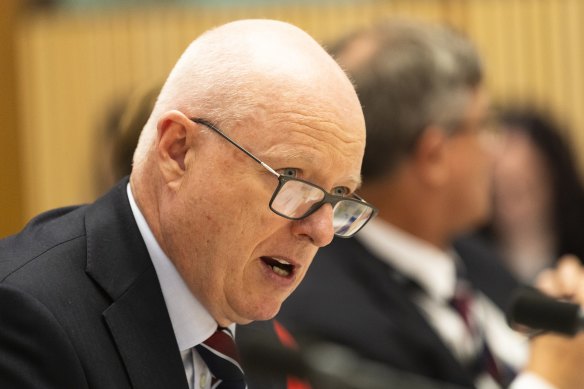- Exclusive
- Environment
- Weather
- Workplace culture
This was published 10 months ago
BoM loses illegal sacking case as staff condemn ‘toxic’ and ‘chaotic’ culture
By Caitlin Fitzsimmons and Nick O'Malley
The Bureau of Meteorology has lost a bitterly fought unfair dismissal case that dates back more than five years, while a raft of current and former employees have come forward to describe the workplace culture as “toxic” and “chaotic”.
The Commonwealth agency dropped its appeal of an unfair dismissal decision in favour of former employee Jasmine Chambers, who joined in 2019 as general manager of global and national science relationships. The appeal case was settled out of court late last month, which means the findings from the earlier judgment stand.

Former Bureau of Meteorology employee Jasmine Chambers outside the Federal Circuit and Family Court of Australia last October.Credit: Rhett Wyman
In a scathing judgment in February, Judge Doug Humphreys, from the Federal Circuit and Family Court of Australia, found the bureau had breached the Fair Work Act in four ways when it drove Chambers out of the organisation in 2020.
The Chambers case concludes as five other current and former employees, speaking on condition of anonymity, have shared claims with this masthead of a “toxic” culture, “chaotic” decision-making, and bullying.
All five claim that part of the reason for low staff morale was an institutional reluctance to deal with questions about climate change and extreme weather at a time when the nation was dealing with mounting climate disasters such as bushfires and floods. The BoM denies these claims.
The first attempt to sack Chambers was made after she took two days of approved personal leave after a work conference in Paris. Several months later, the organisation announced a restructuring that abolished Chambers’ position in what her lawyers described as a “sham redundancy”.
The court criticised several managers, particularly chief executive Dr Andrew Johnson. The former Coalition government appointed Johnson in 2016 and renewed the position for another five years in 2021.
“The court formed the view that Dr Johnson managed the bureau using a close and detailed management style, in which his views were final and not subject to any challenge,” the judgment says.
Mia Pantechis, principal with Maurice Blackburn Lawyers who acted for Chambers, said her client always had a strong case and claimed it was “unnecessarily drawn out” by the BoM, despite established guidelines that Commonwealth agencies should be model litigants.

Bureau of Meteorology head Andrew Johnson giving evidence at Senate estimates in 2022.Credit: Rhett Wyman
“This should have been settled promptly,” Pantechis said. “Instead, it took five years of threatened and actual litigation, and that takes a toll on people who stand up for their workplace rights. That can’t be underestimated.”
Chambers said she was pleased the case had finally concluded, and she hoped it would encourage public institutions such as the BoM to put appropriate governance in place. “I will take some time to gather my thoughts and have more to say in future,” she said.
A BoM spokesperson said the settlement was consistent with its obligations as a model litigant to settle claims where possible and appropriate.
However, the Humphreys judgment found: “The matter was very hard fought both at [the] hearing and in the written submissions. The respondent [BoM] has contested the matter on both fact and law, arguing every available factual and legal point.”
The judge also noted that many of the witnesses who gave evidence on behalf of the bureau had since left the organisation but made no finding on this.
One of the former employees critical of the BoM worked in the communications team and wound up hospitalised for three months in 2022 after the conditions at work aggravated his pre-existing mental illnesses.
In documents seen by this masthead, Comcare accepted liability in 2022 and rejected an appeal by the BoM a few months later.
‘The worst place he’d worked’
In comments to this masthead, the former employee claimed there was a culture of unrealistic expectations, bullying and gaslighting. The veteran public servant, who asked for his name to be withheld to protect his current job, said it was “the worst place [he’d] ever worked”.
“I’d wake up in the morning and feel like vomiting because I knew I’d be hammered from the minute I walked in to 6.30 that evening,” he said.
The employee claimed he knew of colleagues who took extended stress leave, and a large number of people quit in a single year. His managers at the time have also subsequently left.
The BoM spokesperson said a Comcare inspection in December 2022 did not identify any non-compliance with work health and safety legislation. The spokesperson said workplace culture was positive and improving, and staff turnover had declined since 2021–22.
Johnson told estimates earlier this year that the bureau’s culture and morale were “really strong”, referring to the results of the 2023 APS employee survey.
While the survey had some positive results, only about 40 per cent agreed that the senior executive level worked as a team and communicated effectively with the rest of the agency. Twenty-eight per cent said that change was managed well, 17 percentage points lower than other large public service organisations.
A BoM spokesperson said this was not unusual, given the organisation had undergone significant change.
Another former BoM communications employee claimed she had left because she found it distressing to work for the organisation as she believed it deliberately hampered media reporting of climate change.
She claimed that whenever a journalist contacted the BoM with a simple request that mentioned climate change or severe weather, communications officers were instructed to prepare a briefing about the reporter and the questions along with a proposed response, which then had to be cleared by four layers of management and sometimes the chief executive, who often did not approve the prepared statement.
No interviews with the BoM’s experts were to be granted, and statements could only be written, resulting in thin responses that were often too late for journalists’ deadlines. She believed this approach was because the chief executive was sympathetic to the former government and then-prime minister Scott Morrison, and climate change policy was known to be a contentious political issue.
Culture of silence
In 2022, this masthead quoted Professor Scott Power, a senior principal research scientist who quit the bureau in 2020, who described a culture of silence over climate change at the time.
The BoM spokesperson said neither the current nor former government had given any formal or informal directive about how the organisation should communicate about climate change. The spokesperson denied that approvals for media commentary on climate change went as high as the chief executive’s office, saying it followed the standardised process for all media approvals in place for many years.
The spokesperson pointed to the chief executive’s many statements to budget estimates affirming that the increase in both atmospheric land and ocean temperatures was because of human activity. However, the spokesperson said the bureau’s role was to provide data, not to analyse or determine how to respond to the threat.
The spokesperson said the BoM employed 297 meteorologists and 28 climatologists, and these experts “regularly and publicly communicate the results of peer-reviewed climate change status and trends, consistent with the bureau’s role and capability”.
The judgment in the unfair dismissal case established that Chambers took a pay cut from her former university role to accept the role at the BoM and was promised she would be entitled to business class flights for work travel.
The attempts to fire Chambers started five years ago, after she took two days of approved personal leave after a work conference in Paris. When she returned, she was told she would be audited because she had flown business class, taken leave, and claimed expenses only available to more senior staff.
In August 2019, her boss, chief scientist Dr Gilbert Brunet, who had approved the trip including all leave, told her she had not passed probation and would be dismissed, despite having earlier given positive feedback. Chambers said she would seek an injunction, and the BoM made undertakings not to sack her.
In November 2019, Chambers’ performance was again rated by Brunet as unsatisfactory. Chambers complained to the merit protection commissioner, who found the assessment to be wrong and unsupported by evidence.
Later that month, the BoM announced a restructure that would make Chambers’ position redundant and replace it with a position at the same grade but allegedly a different job description.
Chambers’ employment ceased a year later, in December 2020, and the bureau advertised the new role in July 2021.
Get to the heart of what’s happening with climate change and the environment. Sign up for our fortnightly Environment newsletter.